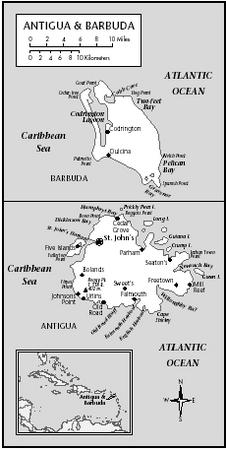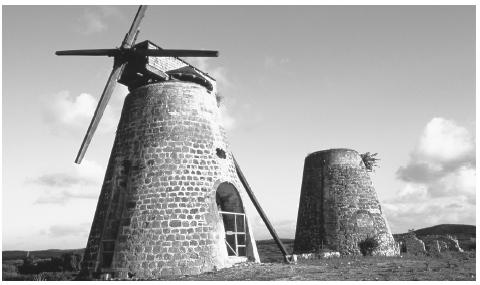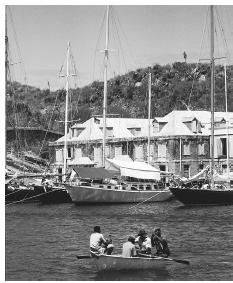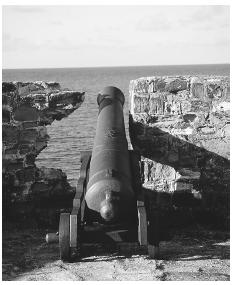Antigua and Barbuda
Culture Name
Antiguan; Antiguan creole; creole; Barbudan
Orientation
Identification. The culture of Antigua and Barbuda (local creole pronunciation, Antiga and Barbueda) is a classic example of a creole culture. It emerged from the mixing of Amerindian (Carib and Arawak), West African, and European (primarily British) cultural traditions. Specific traces of these parent cultures as well as influences from other Caribbean islands (e.g., reggae from Jamaica) are still very evident in this emergent culture. Before Christopher Columbus arrived in 1493, Antigua and Barbuda had the Carib names of Wadadli and Wa'omoni, respectively.
Location and Geography. Antigua and Barbuda are two islands in the Eastern Caribbean chain. Antigua, or Wadadli, has an area of 108 square miles, (280 square kilometers) while Barbuda, or Wa'omoni, is 62 square miles (160 square kilometers) in area, making for a twin island microstate of 170 square miles (440 square kilometers). This state includes the tiny (by Caribbean standards) island of Redonda, which has remained uninhabited. Antigua is an island of both volcanic origin and sedimentary rock (limestone) formation. Its jagged coastline is over 90 miles (145 kilometers) long, producing hundreds of beautiful white sand beaches, bays, and coves. Barbuda is of limestone formation and very flat. The highest point on the island rises to only 128 feet (39 meters). The capital of this state is Saint John's, which is located at the northwestern end of Antigua.
Demography. The population census of 1991 estimated the population of Antigua and Barbuda to be 64,252. Approximately 93 percent of this total are Afro-Antiguans and Barbudans, 0.2 percent are Portuguese, 0.6 percent are Middle Eastern, 1.7 percent are whites from Europe and North America, and 3.4 percent are mixed. The 1997 estimate by the Department of Statistics placed the population at 69,890 and projected a figure of 72,310 for 2000. These increases are the result of significant inflows of migrants from Guyana, Dominica, and the Dominican Republic. Migrants from the latter have given rise to a small Spanish-speaking community on Antigua.
Linguistic Affiliation. Given the creole nature of its culture, it is not surprising that the language spoken by the vast majority of Antiguans and Barbudans is a creole, often referred to as Antiguan creole. This makes the culture a bilingual one. The other language is standard English, which is the official language and the language of instruction. This linguistic situation derives from the colonial history of the nation, which was one of 350 years of near continuous British rule. Consequently, Antiguan creole is essentially a hybrid product of West African languages and English. Although linguists have identified African words such as nyam (eat) in Antiguan creole, the vocabulary of this language consists largely of English words and distinct creole formations ( gee = give) or distinct usages of English words. As one moves up the class hierarchy, there is a gradual shift from creole to English as the first language.
Symbolism. The cultural symbols that embody the national identity of Antigua and Barbuda emerged out of the anticolonial struggles for political independence, which began in the 1930s. Consequently these symbols tend to be images that celebrate liberation from a number of oppressive conditions and periods in the history of the nation: the ending of slavery in 1834, the rise of the labor movement in the 1930s, the revival of African elements in the national culture during the 1960s, and the still ongoing enhancing of the nation's creole culture vis-á-vis Western and particularly British and American culture. Good examples of these symbols are the national anthem, the flag, and the national

History and Ethnic Relations
Emergence of the Nation. The emergence of Antigua and Barbuda as an independent nation was the result of the confluence of a number of international currents with the local struggles for decolonization. The turning point in this history of anticolonial struggle was the series of peasant/worker insurrections that occurred in the Caribbean between 1935 and 1939, with the latter year being the one in which Antiguan and Barbuduan workers and peasants revolted. Out of this revolt came the formation of the Antigua Trades Labor Union (ATLU) in 1939. The need for such an organization was recognized by several individuals—a group that included Harold Wilson, Norris Allen, Reginald Stevens, and V. C. Bird. Allen took the lead by calling the meeting at which the union was formed. Stevens was its first president and Berkeley Richards its first general secretary.
As the union got more deeply involved in the struggles of workers against sugar plantation owners, it became increasingly political. It very quickly developed a "political arm," which later became the Antigua Labor Party (ALP). This radicalization increased under the leadership of Bird, the ATLU's second president. Bird vigorously pushed a heady mix of laborism and state capitalism that came to be known locally as milk and water socialism.
Further, through its political arm, the ATLU began successfully contesting the small number of seats in the legislature that were elective. The resulting acquisition of a measure of state power changed the balance of forces in the struggles of workers with plantation owners. Between 1940 and 1951, universal adult suffrage and self-government became high-priority demands of the union. From this point on the labor movement could not be distinguished from the nationalist movement. This politicization led to new rounds of strikes and political confrontations with the planters and the elites of the colonial state. These struggles, reinforced by those in other Caribbean territories, by the struggles in African countries, and by the opposition of the United States and Russia to European colonial policies, finally pushed the British to dismantle their empire. The dismantling was executed via a process of constitutional decolonization that gradually transferred sovereignty to a set of elected leaders such as those of the ALP. Between 1950 and 1981, when Antigua and Barbuda achieved independence from Britain, there were at least five important sets of decolonizing constitutional changes that paved the way to national independence. As the leader of the ALP, Bird was the nation's first prime minister.
Ethnic Relations. Behind the late twentieth century reviving and respecifying of the place of Afro-Antiguans and Barbudans in the cultural life of the society, is a history of race/ethnic relations that systematically excluded them. Within the colonial framework established by the British soon after their initial settlement of Antigua in 1623, five distinct and carefully ranked race/ethnic groups emerged. At the top of this hierarchy were the British, who justified their hegemony with arguments of white supremacy and civilizing missions. Among themselves, there were divisions between British Antiguans and noncreolized Britons, with the latter coming out on top. In short, this was a race/ethnic hierarchy that gave maximum recognition to Anglicized persons and cultural practices.
Immediately below the British were the mulattos, a mixed race group that resulted from unions between black Africans and white Europeans. Mulattos were lighter in shade than the masses of black Africans, and on that basis distinguished themselves from the latter. They developed complex ideologies of shade to legitimate their claims to higher status. These ideologies of shade paralleled in many ways British ideologies of white supremacy.
Next in this hierarchy were the Portuguese— twenty-five hundred of whom migrated as workers from Madeira between 1847 and 1852 because of a severe famine. Many established small businesses and joined the ranks of the mulatto middle class. The British never really considered Portuguese as whites and so they were not allowed into their ranks. Among Portuguese Antiguans and Barbudans, status differences move along a continuum of varying degrees of assimilation into the Anglicized practices of the dominant group.
Below the Portuguese were the Middle Easterners, who began migrating to Antigua and Barbuda around the turn of the twentieth century. Starting as itinerant traders, they soon worked their way into the middle strata of the society. Although Middle Easterners came from a variety of areas in the Middle East, as a group they are usually referred to as Syrians.
Fifth and finally were the Afro-Antiguans and Barbudans who were located at the bottom of this hierarchy. Forced to "emigrate" as slaves, Africans started arriving in Antigua and Barbuda in large numbers during the 1670s. Very quickly they came to constitute the majority of the population. As they entered this hierarchy, Africans were profoundly racialized. They ceased being Yoruba, Igbo, or Akan and became Negroes or Blacks. This racialization biologized African identities, dehumanizing and deculturing them in the process. As Negroes, it was the body and particularly its skin color that emerged as the new signifiers of identity. As a result, Afro-Antiguans and Barbudans were reinscribed in a dehumanized and racialized discourse that established their inferiority, and hence the legitimacy of their earlier enslavement and later exploitation as wage laborers.
In the last decade, Spanish-speaking immigrants from the Dominican Republic and Afro-Caribbea immigrants from Guyana and Dominica have been added to this ethnic mosaic. They have entered at the bottom of the hierarchy and it is still too early to predict what their patterns of assimilation and social mobility will be.
Food and Economy
Food in Daily Life. Antigua and Barbuda has long imported most of its food, so it is not surprising that the food eaten by Antiguans and Barbudans consists of creole dishes or specialties that reflect the cuisine of the parent cultures. In recent years, there has been a strong invasion of American fast-food chains, such as Kentucky Fried Chicken. Among the more established creole specialties of Antigua and Barbuda are rice pudding, salt fish and antrobers (eggplant; the national breakfast), bull foot soup, souse, maw, goat water, cockle (clam) water, conch water, and Dukuna. The salted cod used in making the national breakfast is not a local fish. It is an import from the United States and Canada that has been imported since before the revolt of the American colonies.
Major Industries. Sugar dominated the economy of Antigua and Barbuda for much of its history. The period of sugar dominance began in the 1660s after the failure of attempts to make money from tobacco. Between 1700 and 1775, Antigua and Barbuda emerged as a classic sugar colony. Because of its exclusive specialization in sugar, the economy was not very diverse. Consequently, it imported a lot, including much of its food from the American colonies and Britain.
After 1775, the economy entered a long period of decline that ended almost two centuries later in 1971. The revolt of the American colonies (1776), the suspension of the British slave trade (1804), the British vote to end slavery (1834), and the British conversion to free trade (1842) all combined to destroy the foundations of the sugar-based economy. The American revolution took away Antigua and Barbuda's cheap food supplies, the changes in British slave policies cut off its labor supplies, while the changes in trade policy took away its guaranteed market. The result was a decline from which sugar never really recovered, along with the need for a new leading sector.

Concerted efforts at industrialization in the 1940s and 1950s failed. Attracted to Antigua and Barbuda's many beaches, white sands, and sunny climate, wealthy Americans found it a great place to vacation. Out of this demand, tourism emerged as the new leading and rapidly growing sector of the economy. In 1958 tourist arrivals totaled 12,853; by 1970, on the eve of sugar's demise, they had risen to 67,637. In 1998 tourist arrivals reached 204,000. The impact of tourism on the growth of the national economy has been significant. In 1973 the gross domestic product (GDP) of the economy was US $73.3 million. By 1998 the GDP had reached US $423 million. In 1973 the hotel and restaurant sector accounted for 7.9 percent of the nation's GDP. By 1979, the figure had doubled to 14 percent, where it remained into the twenty-first century.
In spite of the growth in tourism and its expansive impact on the construction and transportation sectors, the economy is still not diversified. As in the sugar period, there is an overspecialization that keeps imports high, including food. By the late 1980s, the environmental impact of tourism had become a major political issue, with groups of environmentalists blocking the construction of new hotels.
The newest emerging sector is offshore banking. Because of the secretive and confidential aspects of this industry, it is emerging under clouds of controversy. The government, however, is committed, to its development.
The currency of Antigua and Barbuda is the Eastern Caribbean dollar, which has had a fairly steady exchange rate of approximately 2.70 with the U.S. dollar.
Social Stratification
Classes and Castes. Like many other Caribbean societies, Antigua and Barbuda is a classic case of the superimposition of race on class and vice versa. Consequently, the class structure reflects very much the race/ethnic hierarchy described earlier. Until the rise of the nationalist movement, the dominant class was clearly the British sugar planters. They monopolized the labor of the masses of Afro-Antiguans and Barbudans, who also constituted the subordinate working class. Between these two extremes was a middle class that consisted of the same three groups that occupied the middle layers of the race/ethnic hierarchy—the mulattos, Portuguese, and Syrians. The mulattos dominated the professions (law, medicine, and architecture) and the white-collar positions in banks, businesses, and the

In the postcolonial period, there have been significant changes in this class structure even though its basic categories and rank orderings have remained. At the top, hotel owners and offshore bankers have replaced the planters. These are primarily white Americans, with British investors regaining some ground. At the bottom is a working class that is still predominantly Afro-Antiguan and Barbudan. Because of recent changes in immigration policies, however, significant numbers of Afro-Guyanese and Afro-Dominican workers have been added to the ranks of this class. Thus the bottom of the class hierarchy remains primarily black even though the work has shifted from plantations to hotels.
Important changes have also occurred in the middle levels of the class hierarchy. This layer has ceased to be a predominantly mulatto class and has become one that is predominantly black. This shift was a direct consequence of changes in patterns of black social mobility produced by black control of the decolonized state. Nevertheless, the middle class still retains its mulatto, Portuguese, and Syrian components.
Political Life
Government. The political institutions of Antigua and Barbuda have gone through three basic stages: a period of colonial plantocratic democracy (1623–1868), a phase of colonial authoritarianism (1868–1939), and a period of liberal democracy (1940– present). Since the enactment of universal suffrage in 1951, elections have been contested every five years without major interruptions. But because of informal pressures and ways of accumulating power, the political system has oscillated between periods of one-party and two-party dominance, with the latter occurring from 1943 to 1967, and the former in two periods: 1968–1980 and 1992 to the present.
Marriage, Family, and Kinship
Marriage. Families in Antigua and Barbuda are creole formations. Among the white upper class creolization is minimal. Patterns of marriage, family organization, and gender roles are similar to those in the West with minor local adaptations. Much the same is true of the middle classes except for the greater presence of local adaptations. Among the black working class, family life is much more a mixture of the African and European systems. Although the institutions of bridewealth (marriage payments) and lineage groups have been lost, the African view of marriage as a process occurring over many years has been retained. Without the sanction of bridewealth, family for a young couple begins in what have been called visiting relationships, which often become coresidential, and may finally issue in a formal marriage ceremony that is Christian. Like many African families, these creole families are matrifocal, centering on the mother's lineage, with strong traditions of women working outside of the home. There are, as a result, very high rates of labor force participation for Antiguan and Barbudan women.

Religion
Religious Beliefs. The religious life of Antiguans and Barbudans is predominantly Christian. In 1991, 32 percent of the population was Anglican, 12 percent was Moravian, 10 percent was Catholic, and 9 percent Methodist. This Christian orientation, however, is a creolized one that changes as we move up the class hierarchy. For most of their history, the churches of Antigua and Barbuda were colonial institutions—overseas branches of England-based churches, whose pastors were in control. Thus, unlike the African American church, the Afro-Antiguan and Barbudan church does not have a long history of autonomous development. Autonomy came with the independence of the state.
In spite of this Anglicization, religious practices have not escaped creolization. Among Afro-Antiguans and Barbudans, traces of the African religious heritage have survived in the practice of Obeah and in inclinations toward more ecstatic modes of worship. The postcolonial period has witnessed a significant creolizing of church music, which has been influenced by calypso, reggae, and African American gospel music.
The Arts and Humanities
The more developed art forms of Antigua and Barbuda are mas (street theater), theater, calypso, steel band, architecture, poetry, and fiction. Less well developed are the arts of painting, sculpture, and carving. In the case of the more developed art forms, processes of cultural hybridization have successfully produced distinct creole formations that are expressively linked to the subjectivity and rituals of Antiguans and Barbudans.
Literature. In the area of fiction and poetry, writers include Jamaica Kincaid, Ralf Prince, Elaine Olaoye, and Dorbrene Omard.
Performance Arts. Good examples of distinct creole formations are calypso and steel band. Set to a distinct rhythmic beat, calypsos are songs of social commentary that range from the comic to the tragic. One of the major consequences of decolonization on this art form has been its expansion to include religious themes and situations. Among the calypso kings of Antigua and Barbuda are Short Shirt, Swallow, Obstinate, Onyan, and Smarty Jr.
One of the few musical instruments invented in the twentieth century, steel bands consist of a number of "pans"—base pans, tenor pans, etc. They are made by pounding the basic notes out of the surface of steel drums used to transport oil. Bands range in size from about ten to one hundred pans. Developed first in Trinidad in the 1930s, the tradition spread quickly to Antigua and Barbuda. Well-known steel bands from Antigua and Barbuda include Brute Force, Hells Gate, Harmonites, Supa Stars, and Halcyon.
The State of the Physical and Social Sciences
The sciences are not well developed in Antigua and Barbuda. Natural sciences such as physics and chemistry are particularly weak. This is also true for the larger Caribbean region. The practice of science in the region is located primarily at the University of the West Indies, whose main campuses are in Jamaica, Trinidad, and Barbados. The university's extramural department, however, has a branch in Antigua, where the first year of the bachelor's degree in some of the social sciences can be done, with the remainder being completed at one of the main campuses. The most prominent science journals are in the social sciences, which are led by economics and political science. Among Antigua and Barbuda's outstanding contributions to the pool of regional scientists are Ashly Bryant, Percival Perry, Samuel Daniel, Ermina Oshoba, Vincent Richards, and Enoch James.
Bibliography
Davis, Gregson. Antigua Black, 1973.
Gaspar, David Barry. Bondmen and Rebels, 1985.
Henry, Paget. Peripheral Capitalism and Underdevelopment in Antigua, 1985.
Kincaid, Jamaica. Annie John, 1985.
——. A Small Place, 1988.
Langhan, Mrs. Antigua and Antiguans, 1844.
Olaoye, Elaine. Passion of the Soul, 1998.
Oliver, V. The History of the Island of Antigua, 1894.
Prince, Ralf. Jewels of the Sun, 1979.
Richards, Novelle. The Struggle and the Conquest, 1967.
——. The Twilight Hour, 1971.
Smith, Keithlyn. No Essay Pushover, 1994.
Tongue, Gwen. Cooking Antigua's Food, 1973.
—P AGET H ENRY
Devon Brooks : is that all you can think about saying? go read an encyclopedia if you want useless detail like that... this is a bit deeper !
I would like to know were is the former hotel Antigu Beach Hotel in Cables Beachotel now in Antigua?
Could you help me?
Thankd in advance
Best regards
F Le Pesant
We are Black: We are White: as a matter of fact, we are from all over the world. What colour are we?
Im living in a very small country called Guyana in Saouth America and the Caribbean. Im writing yout his little note to tell yout hat i have found this page very helpful. I copied and pasted the relevant infortmation in word document, and printed it out.
The information on this page will assist a student who is preparing to write the national Common Entrance in May. This is an examination that all the students in this particualr grade in primary schools all around the caribbean will sit.
Again i must say that this page is very helpful and imformative>
P.S. I found this oage by susing the Google search engine :)
Ashley Williams
Excellent books and lots of information going back to the 1950's.
Nalda